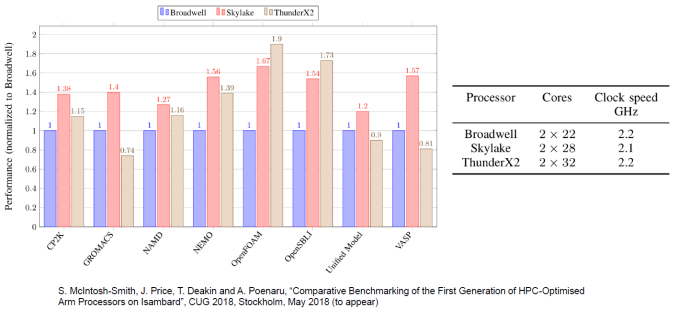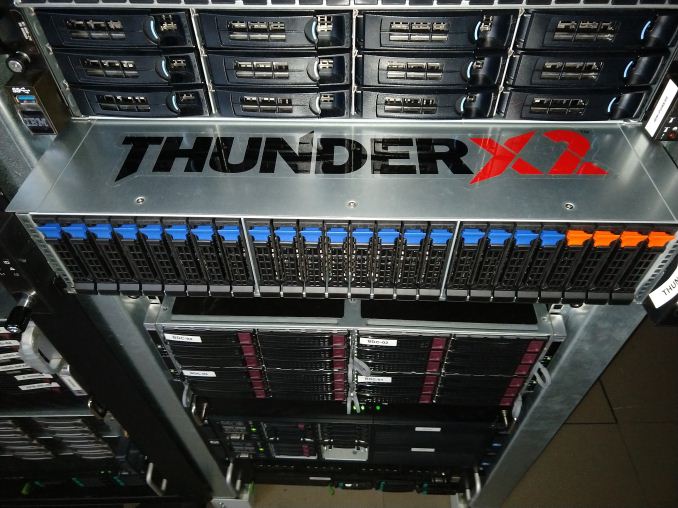Assessing Cavium's ThunderX2: The Arm Server Dream Realized At Last
by Johan De Gelas on May 23, 2018 9:00 AM EST- Posted in
- CPUs
- Arm
- Enterprise
- SoCs
- Enterprise CPUs
- ARMv8
- Cavium
- ThunderX
- ThunderX2
What We Can Conclude: So Far
Wrapping things up, our SPECInt analyses show that the ThunderX2 cores still has some weaknesses. Our first impression is that branch intensive code – especially in combination with regular L3-cache misses (high DRAM latency) – run quite a bit slower. So there will be corner cases where the ThunderX2 is not the best choice.
However, other than some niche markets, we are pretty confident that the ThunderX2 will be a solid performer. For example, the performance measurements done by our colleagues at the University of Bristol confirm our suspicion that memory intensive HPC workloads such as OpenFoam (CFD) and NAMD.run really well on the ThunderX2
From the early server software testing we have done so far, we can only be pleasantly surprised. The performance-per-dollar of the ThunderX2 in both Java Server (SPECJbb) and Big Data processing is – right now – by far the best in the server market. We have to retest AMD's EPYC server CPU and a Gold version of the current generation (Skylake) Xeon to be absolutely sure, but delivering 80-90% of the performance of the 8176 at one fourth of the cost is going to very hard to beat.
As an added benefit to Cavium and the ThunderX2, here in 2018 the Arm Linux ecosystem is now mature; specialized Linux kernels and other tools are no longer necessary. You just install Ubuntu Server, Red Hat, or Suse, and you can automate your deployments and software installation from the standard repositories. That is a massive improvement compared to what we experienced back when the ThunderX was launched. Back in 2016, simply installing from the regular Ubuntu repositories could cause problems.
So all in all, the ThunderX2 is a very potent contender. It might even be more dangerous to AMD's EPYC than to Intel's Skylake Xeon thanks to the fact that both Cavium and AMD are competing for much of the same pool of customers considering switching away from Intel. This is because the customers who have invested in expensive enterprise software (Oracle, SAP) are less sensitive to cost on the hardware side, so they are much less likely to change to a new hardware platform. And those people have been investing the past 5 years in Intel as it was the only option.
That in turn means that those who are more agile and cost sensitive, such as hosting and cloud providers, will now be able to choose an Arm server CPU alternative with an excellent performance-per-dollar ratio. And with HP, Cray, Pengiun computing, Gigabyte, Foxconn, and Inventec all offering systems based upon the ThunderX2, there isn't a shortage of quality vendors.
In short, the ThunderX2 is the first SoC that is able to compete with Intel and AMD in the general purpose server CPU market. And that is a pleasant surprise: at last, an Arm server solution that delivers!












97 Comments
View All Comments
Gunbuster - Wednesday, May 23, 2018 - link
Because it's hard to explain the critical line of business software or database is having some unknown edge case issue because you thought look at me I'm so smart and saved 1% of the project cost using unproven low penetration hardware.daanno2 - Wednesday, May 23, 2018 - link
I'm guessing you've never dealt with expensive enterprise software before. They are mostly licensed per-core, so getting the absolute best performance per core, even if the CPU is 2-3x more expensive, is worth it. At the end of the day, the CPUs might be <5% of the total cost.SirPerro - Wednesday, May 23, 2018 - link
You can swallow a big risk if the benefit is 75% of the cost. Hey, it's definitely worth the try.If your hardware makes up for 5% of the cost, saving a 3% of the total budget is not worth the risk of migration.
FunBunny2 - Thursday, May 24, 2018 - link
"You can swallow a big risk if the benefit is 75% of the cost. Hey, it's definitely worth the try."the EOL of today's machines, the amortization schedules must be draconian. only if a 'different' server pays off in dozens of months, not years, will it have chance. to the extent that enterprise software is a C/C++ and *nix codebase, porting won't be onerous. but, I'm willing to guess, even Oracle code isn't all that parallel, so throwing a truckload of teeny cpu at it won't necessarily work.
name99 - Thursday, May 24, 2018 - link
The bigger problem here is the massive uncertainty around the meaning of the word "server" and thus the target for these new ARM CPUs.Some people seem to think "server" means primarily boxes that run SAP or ORACLE, but I think it's clear that the ARM ecosystem has little interest in that, at least right now.
What's of much more interest is racks on racks of CPUs running commodity (LAMP) or homegrown software, ie data warehouses and HPC. I'm not even sure the Java benchmarks being run are of much interest to this market. The things that matter are the sorts of things Cloudflare was measuring when they tested Centriq -- memcached, nginx, transforming one type of data into another (compression/decompression, encrypt/decrypt, transcode,...) at massive throughput.
That's where I'd expect to see the big sales of the ARM "server" cores -- to Cloudflare, Baidu, Google, and so on.
Also now that Marvell is in the game, will be interesting to see the extent to which they pull this downward, into their traditional sorts of markets like infrastructure network and storage control (eg to go into network appliances and NAS boxes).
Ed469546 - Wednesday, June 13, 2018 - link
Some of the commercial software you pay per core. Intel had the best single threaded performance mening power license costs.Interesting question is how the Thunderx2 cores are counted in this case: one core can run 4 threads.
andrewaggb - Wednesday, May 23, 2018 - link
I wonder what workloads they are targeting? High throughput with poor single threaded results is somewhat limiting.peevee - Wednesday, May 23, 2018 - link
Web app servers. VM servers. Hadoop/Spark nodes. All benefit more from having more threads running in parallel instead of each request waiting or switching contexts.If you are concerned about single-thread performance on 256-thread server (as 2-CPU server with this CPU will provide) AT ALL, you choose outrageously wrong hardware for the task to begin with. Go buy a 2-core i3. Practically the only test in this article which matters is Critical jOPS (assuming the used quality of service metric was configured realistically).
GeekyMcGeekface - Friday, May 25, 2018 - link
I’m building a cluster now with a few hundred Raspberry Pi’s because scale up is expensive and stupid. By distributing across a pool of clusters, I can handle far more memory bandwidth and compute. Consider 100 Raspberry PIs have 400 64-bit cores and 100GB of RAM. Total cost $3500 + power, mounting and switches.Running three clusters of those with Kubernetes, Couchbase and Azure Functions provides 1200 64-bit cores, about 100GB of extremely high performance storage, incredible failover and a map-reduce environment to die for.
Add some 64GB MicroSD cards and an object storage system to the cluster and there’s 12TB of cold storage (4TB when made redundant).
Pay a service fee to some sweatshop in the Eastern Block to do the labor intensive bits and you can build a massively parallel, almost impossible to crash, CI/CD friendly, multi-tenant, infinitely scalable PaaS... for less than the cost of the RAM for a single one of the servers here.
The only expensive bits in the design are the Netscalers.
Oh... and the power foot print is about the same as one of these servers.
I honestly have no idea what I what I would use a server like these in a new design for.
jospoortvliet - Wednesday, May 30, 2018 - link
single-core performance with your pi's is considerably lower, as is inter-core bandwidth. If your tasks require little inter-process communication you're good but with highly interdependent compute it won't perform well. But for specific tasks, yes, it might be very cost effective.